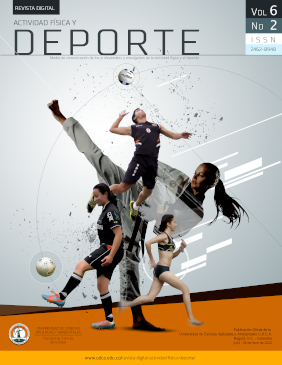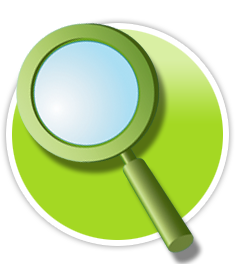IDENTIFICAR LA LATERALIDAD EN NIÑOS DE 2 A 5 AÑOS DEL INSTITUTO DE RECREACIÓN Y DEPORTES DE TUNJA (IRDET) APLICANDO EL TEST DE HARRIS
IDENTIFY THE LATERALITY IN CHILDREN FROM 2 TO 5 YEARS OLD FROM THE INSTITUTE OF RECREATION AND SPORTS OF TUNJA (IRDET) THROUGH THE HARRIS TEST
Contenido principal del artículo
Resumen
Introducción: Esta investigación busca mejorar los procesos de desarrollo temprano en los niños, de 2 a 5 años, evaluando las estrategias de mejora de la lateralidad, que adelantan dentro del Instituto de Recreación y Deportes de Tunja (IRDET) y configurando técnicas innovadoras, a través de la aplicación del test de Harris. Objetivo General: Mejorar la lateralidad de los niños entre 2 y 5 años de edad del Instituto de Recreación y Deportes de Tunja, Boyacá, usando el test de Harris (o test de dominancia lateral de Harris) como estrategia para identificación temprana. Metodología: Esta investigación está dentro del enfoque cualitativo, el diseño en que se apoyó es la investigación acción. La investigación se llevó a cabo en 84 niños (40 niñas, 44 niños) del programa de desarrollo Psicomotor del IRDET. Para obtener este objetivo se aplicó el test de Harris en cuatro grupos de acuerdo con la edad, género y física educación de la siguiente forma:1.-10 niñas y 13 niños de entre 2 y 3 años; 2.-16 niñas y 11 niños de entre 3 y 4 años; 3.- 7 niñas y 11 niños de entre 4 y 5 años; 4.- 7 niñas y 9 niños de entre 5 y 6 años. Resultados: El test de Harris se aplicó individualmente a cada niño, con el objeto de evaluar sus diferentes habilidades psicomotrices se hicieron diferentes pruebas en relación a la lateralidad superior (10 pruebas para manos), lateralidad inferior (10 pruebas para pies), auditiva (3 pruebas para oídos) y ocular (3 pruebas para ojos). Conclusiones: Mostraron niños con diferentes grados de lateralidad de acuerdo a su desarrollo psicomotriz, es decir, niños de dos años de edad presentaron diferencias tendencias de lateralidad en comparación con niños de 4 y 5 años edad. En este trabajo se argumentó la relación existente entre la edad y el desarrollo de la lateralidad de los niños del programa de desarrollo Psicomotor del IRDET.
Palabras clave:
Descargas
Datos de publicación
Perfil evaluadores/as N/D
Declaraciones de autoría
- Sociedad académica
- Universidad de Ciencias Aplicadas UDCA
- Editorial
- Universidad de Ciencias Aplicadas y Ambientales U.D.C.A
Detalles del artículo
Referencias (VER)
AMAR, J. 2004. Desarrollo infantil y construcción psicológica del mundo social. Uninorte. Barranquilla.
ARCILA, J. 2015. Corporeidad, arte y escuela. Publicación del Instituto para la Investigación Educativa y el Desarrollo Pedagógico. Ed. Magazín Aula Urbana (Número 97).
AUSUBEL, D. 2002. Adquisición y retención del conocimiento. Una perspectiva cognitiva. Ed. Paidós. Barcelona.
BAGLIETTO, T.; BALLESTEROS, A.; BARCELO, M. 2001. Hacia una economía del conocimiento. ESIC-EDITORIAL. Madrid.
BARROSO, C.; FONTECHA, M. 1999. La importancia de las dramatizaciones en el aula de ele: Una propuesta concreta de trabajo de clase. ADES (Asociación para la difusión del español y la cultura hispánica). Madrid.
BENJUMEA, M. 2009. Elementos constitutivos de la motricidad como dimensión Humana. Universidad de Antioquia. Medellín, Colombia.
BETANCOURT, J. 1997. La creatividad y sus implicaciones. Editorial Académica.
BIXIO, C. 1998. Enseñar a aprender. Como construir un espacio colectivo de enseñanza aprendizaje. Ediciones Rosario: Homo sapiens. México.
CHAUX, E.; BUSTAMANTE, A.; CASTELLANOS, M.; JIMÉNEZ, M.; NIETO, A.; RODRÍGUEZ, G.; BLAIR, R.; MOLANO, A.; RAMOS, C.; VELÁSQUEZ, A. 2008. Aulas en paz 2: Estratégicas pedagógicas. Revista Interamericana de Educación para la democracia.
CSIKSZENTMIHALYI, M. 1996. Creativity. Flow and the psychology of discovery and invention. HarperCollins Publishers. New York.
CUERVO, J. 2007. Las políticas públicas entre los modelos teóricos y la práctica gubernamental. Universidad Externado de Colombia. Bogotá, D.C.
FUNCIÓN PUBLICA. 1994. Ley 115. 1994. Ley general de educación. Educación preescolar. Sección segunda de 1994.
GAGNÉ, R. 1971. Las condiciones de aprendizaje. Editorial Aguilar. Madrid, España.
GROTOWSKI, J. 1970. Hacia un Teatro Pobre. Editores Siglo Veintiuno. México.
HURWITZ, S. 2007. Permiso para improvisar. Revista Gestión. 10(1).
JARAMILLO, L. 2007. Aspecto legal para la organización de un centro escolar: Legislación de un establecimiento educativo a nivel preescolar. Disponible desde Internet en: http://ylang-ylang.uninorte.edu.co:8080/drupal/files/LegislacionEstEducativol-Preescolar.pdf
JENSEN, E. 2004. Cerebro y aprendizaje: competencias e implicaciones educativas. Editorial Narcea. Madrid, España.
KAPLUN, M. 1992. A la educación por la comunicación. La práctica de la comunicación educativa. Oficina Regional de Educación de la UNESCO para América Latina y el Caribe (OREALC). Santiago de Chile.
LOAIZA, L. 2008. Pedagogía y teatro. Revista Colombiana de las Artes Escénicas, 2(1).
MARTÍNEZ, M. 1993. Calidad educacional, actividad pedagógica y creatividad. Editorial académica. Barcelona, España.
MCLUHAN, H. 1987. El medio es el mensaje un inventario de efectos. Editorial Paidós. Barcelona.
MÉLICH, J. 1994. Del extraño al cómplice. La educación en la vida cotidiana. Editorial Anthropos. Barcelona, España.
MEN. 1993. Lineamientos curriculares en educación artística. Educación en teatro. Bogotá, D.C.
MEN. 2006. Documento No. 3: Una construcción colectiva por el mejoramiento integral de la gestión educativa. Bogotá, D.C.
MORALES, J. 2002. Concepto de hombre y educación. Institución Universitaria CEIPA. Medellín, Antioquia.
NONAKA, I.; TAKEUCHI, H. 1999. La organización creadora de conocimiento. Cómo compañías japonesas crean la dinámica de la innovación. Editorial Oxford. México.
NUMES, P. 1995. Educación Lúdica: Técnicas y juegos pedagógicos. Ediciones San Pablo. Bogotá, Colombia.
PACHECO, G. 2015. Expresión Corporal en el Aula Infantil. Algunas consideraciones conceptuales (Primera Edición ed.). Quito, Ecuador: Formación académica.
PALACIOS, J. 1978. La cuestión escolar críticas y alternativas. Editorial LAIA. Barcelona, España.
PETRO, G. 2012. Plan de Desarrollo en el Concejo. El Espectador. Bogotá, D. C.
ROTH, A. 2009. Políticas públicas, formulación, implementación y evaluación. Editorial Aurora. Bogotá, D.C.
SCHWANDT, T. 1994. Constructivist, interpretivist approaches to human inquiry. En: DEZIN, N.; LINCOLN, Y. Handbook of qualitative research. Thousand Oaks. Sage Publications. Londres, Inglaterra.
SENGE, P. 1999. La quinta disciplina. Cómo impulsar el aprendizaje en las organizaciones inteligentes. Ediciones Gránica S.A. Barcelona, España.
TAMAYO, M. 2007. El análisis de las políticas públicas. Madrid, España.
TORREGROSA, J. 2009. Taller de juegos teatrales. Barcelona, España.
VELÁSQUEZ, R. 2010. Definiendo la Política Pública. Departamento de planeación Nacional.








